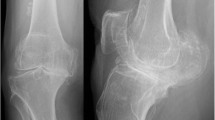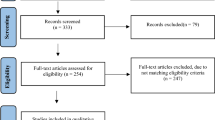Abstract
Purpose
A concern that arises with any new prosthesis is whether it will achieve satisfactory long-term implant stability. The gold standard of assessing the quality of fixation in a new or relatively new implant is to undertake a randomized controlled trial using radiostereometric analysis. It was hypothesized that both mobile-bearing total knee arthroplasty and fixed-bearing total knee arthroplasty have comparable migration patterns at 2-year follow-up. This study investigated two types of cemented total knee arthroplasty, the mobile- or fixed-bearing variant from the same family with use of radiostereometric analysis.
Methods
This prospective, patient-blinded, randomized, controlled trial was designed to investigate early migration of the tibia component after two years of follow-up with use of radiostereometric analysis. A total of 50 patients were randomized to receive a mobile- or fixed-bearing TKA from the same family. Patients were evaluated during 2-year follow-up, including radiostereometric analysis, physical and clinical examination and patient reported outcome measures (PROMs).
Results
At two-year follow-up, the mean (±SD) maximum total point motion (MTPM) in the fixed-bearing group was 0.82 (±1.16) versus 0.92 mm (±0.64) in the mobile-bearing group (p = n.s) with the largest migration seen during the first 6 weeks (0.45 ± 0.32 vs. 0.54 ± 0.30). The clinical outcome and PROMs significantly improved within each group, not between both groups.
Conclusions
Measuring early micromotion is useful for predicting clinical loosening that can lead to revision. The results of this study demonstrate that early migration of the mobile-bearing is similar to that of the fixed-bearing component at two years and was mainly seen in the first weeks after implantation.
Level of evidence
Randomized, single-blind, controlled trial, Level I.



Similar content being viewed by others
References
Ball ST, Sanchez HB et al (2011) Fixed versus rotating platform total knee arthroplasty: a prospective, randomized, single-blind study. J Arthroplasty 26(4):531–536
Breeman S, Campbell MK et al (2013) Five-year results of a randomised controlled trial comparing mobile and fixed bearings in total knee replacement. Bone Joint J 95(4):486–492
Breugem SJ, van Ooij B, Haverkamp D, Sierevelt IN, van Dijk CN (2014) No difference in anterior knee pain between a fixed and a mobile posterior stabilized total knee arthroplasty after 7.9 years. Knee Surg Sports Traumatol Arthrosc 22(3):509–516
Callaghan JJ (2001) Mobile-bearing knee replacement: clinical results: a review of the literature. Clin Orthop Relat Res 392:221–225
Callaghan JJ, Wells CW et al (2010) Cemented rotating-platform total knee replacement: a concise follow-up, at a minimum of 20 years, of a previous report. J Bone Joint Surg Am 92(7):1635–1639
Carothers JT, Kim RH et al (2011) Mobile-bearing total knee arthroplasty. A meta-analysis. J Arthroplasty 26(4):537–542
Collier MB, Engh CA et al (2005) Osteolysis after total knee arthroplasty: influence of tibial baseplate surfacefinish and sterilization of polyethylene insert. Findings at 5 to 10 years postoperatively. J Bone Joint Surg Am 87(12):2702–2708
Delport HP, Banks SA et al (2006) A kinematic comparison of fixed- and mobile-bearing knee replacements. J Bone Joint Surg Br 88(8):1016–1021
Delport HP (2013) The advantage of a total knee arthroplasty with rotating platform is only theoretical: prospective analysis of 1152 arthroplasties. Open Orthop J 7:635–640
Derbyshire B, Prescott RJ, Porter ML (2009) Notes on the use and interpretation of radiostereometric analysis. Acta Orthop 80(1):124–130
Duffy GP, Murray BE, Trousdale RR (2007) Hybrid total knee arthroplasty. Analysis of component failures at an average of 15 years. J Arthroplasty 22(8):1112–1115
Ewald FC (1989) The knee society total knee arthroplasty roentgenographic evaluation and scoring system. Clin Orthop Relat Res 248:9–12
Faris PM, Ritter MA, Davis KEPH (2015) Ten-year outcome comparison of the anatomical graduated component and vanguard total knee arthroplasty systems. J Arthroplasty 30(10):1733–1735
Furnes O, Espehaug B et al (2002) Early failures among 7174 primary total knee replacements: a follow-up study from the Norwegian Arthroplasty Register 1994–2000. Acta Orthop Scand 73(2):117–129
Garling EH, Valstar ER, Nelissen RGHH (2005) Comparison of micromotion in mobile bearing and posterior stabilized total knee prostheses: a randomized RSA study of 40 knees followed for 2 years. Acta Orthop 76(3):353–361
Garling EH, van Eck M et al (2005) Increased muscle activity to stabilise mobile bearing knees in patients with rheumatoid arthritis. Knee 12(3):177–182
Gioe TJ, Glynn J et al (2009) Mobile and fixed-bearing (all-polyethylene tibial component) total knee arthroplasty designs. A prospective randomized trial. J Bone Joint Surg Am 91(9):2104–2112
Grewal R, Rimmer MG, Freeman MA (1992) Early migration of prostheses related to long-term survivorship. Comparison of tibial components in knee replacement. J Bone Joint Surg Br 74(2):239–242
Haverkamp D, Breugem SJM et al (2005) Translation and validation of the Dutch version of the Oxford 12-item knee questionnaire for knee arthroplasty. Acta Orthop 76(3):347–352
Henricson A, Dalén T, Nilsson KG (2006) Mobile bearings do not improve fixation in cemented total knee arthroplasty. Clin Orthop Relat Res 448:114–121
Hofstede SN, Nouta KA et al (2015) Mobile bearing versus fixed bearing prostheses for posterior cruciate retaining total knee arthroplasty for postoperative functional status in patients with osteoarthritis and rheumatoid arthritis. Cochrane Database Syst Rev 4(4):CD003130
Hopley CDJ, Crossett LS, Chen AF (2013) Long-term clinical outcomes and survivorship after total knee arthroplasty using a rotating platform knee prosthesis: a meta-analysis. J Arthroplasty 28(1):68–77
Huang C-H, Liau J-J, Cheng C-K (2007) Fixed or mobile-bearing total knee arthroplasty. J Orthop Surg 2:1
Insall JN, Dorr LD et al (1989) Rationale of the knee society clinical rating system. Clin Orthop Relat Res 248:13–14
Jones DL, Westby MD et al (2005) Update on hip and knee arthroplasty: current state of evidence. Arthritis Rheum 53(5):772–780
Kaptein BL, Valstar ER et al (2005) A new type of model-based Roentgen stereophotogrammetric analysis for solving the occluded marker problem. J Biomech 38(11):2330–2334
Kellgren JH, Lawrence JS (1957) Radiological assessment of osteo-arthrosis. Ann Rheum Dis 16(4):494–502
Kievit AJ, Schafroth MU et al (2014) Early experience with the vanguard complete total knee system: 2–7 years of follow-up and risk factors for revision. J Arthroplasty 29(2):348–354
Kim Y, Kim J et al (2012) Long term comparison of fixed bearing and mobile-bearing total knee replacements in patients younger than fifty-one years of age with osteoarthritis. J Bone Joint Surg Am 94(10):866–873
Kurita M, Tomita T et al (2012) In vivo kinematics of high-flex mobile-bearing total knee arthroplasty, with a new post-cam design, in deep knee bending motion. Int Orthop 36(12):2465–2471
Li YL, Wu Q, Ning GZ et al (2014) No difference in clinical outcome between fixed- and mobile-bearing TKA: a meta-analysis. Knee Surg Sports Traumatol Arthrosc 22(3):565–575
Mikulak SA, Mahoney OM et al (2001) Loosening and osteolysis with the press-fit condylar posterior-cruciate substituting total knee replacement. J Bone Joint Surg Am 83(3):398–403
Molt M, Ljung P, Toksvig-Larsen S (2012) Does a new knee design perform as well as the design it replaces? Bone Joint Res 1(12):315–323
Murray DW, Fitzpatrick R et al (2007) The use of the Oxford hip and knee scores. J Bone Joint Surg Br 89(8):1010–1014
Nilsson KG, Henricson A et al (2006) Uncemented HA-coated implant is the optimum fixation for TKA in the young patient. Clin Orthop Relat Res 448:129–139
Oh KJ, Pandher DS et al (2009) Meta-analysis comparing outcomes of fixed-bearing and mobile-bearing prostheses in total knee arthroplasty. J Arthroplasty 24(6):873–884
Petersen TL, Engh GA (1998) Radiographic assessment of knee alignment after total knee arthroplasty. J Arthroplasty 3(1):67–72
Pijls BG, Valstar ER et al (2012) Early migration of tibial components is associated with late revision: a systematic review and meta-analysis of 21,000 knee arthroplasties. Acta Orthop 83(6):614–624
Post ZD, Matar WY et al (2010) Mobile-bearing total knee arthroplasty. Better than a fixed-bearing? J Arthroplasty 25(6):998–1003
Price AJ, Rees JL et al (2003) A mobile-bearing total knee prosthesis compared with a fixed-bearing prosthesis. A multicentre single-blind randomised controlled trial. J Bone Joint Surg Br 85(1):62–67
Rand JA, Trousdale RT et al (2003) Factors affecting the durability of primary total knee prostheses. J Bone Joint Surg Am 85(2):259–265
Ranstam J, Ryd LOI (2000) Accurate accuracy assessment: review of basic principles. Acta Orthop Scand 71(1):106–108
Ritter MA, Worland R et al (1995) Flat-on-flat, nonconstrained, compression molded polyethylene total knee replacement. Clin Orthop Relat Res 321:79–85
Roorda LD, Jones CA et al (2004) Satisfactory cross cultural equivalence of the Dutch WOMAC in patients with hip osteoarthritis waiting for arthroplasty. Ann Rheum Dis 63(1):36–42
Ryd L, Albrektsson BE et al (1995) Roentgen stereophotogrammetric analysis as a predictor of mechanical loosening of knee prostheses. J Bone Joint Surg Br 77(3):377–383
Saleh KJ, Mulhall KJ et al (2005) Development and validation of a lower-extremity activity scale. Use for patients treated with revision total knee arthroplasty. J Bone Joint Surg Am 87(9):1985–1994
Schroer WC, Stormont DM, Pietrzak WS (2014) Seven-year survivorship and functional outcomes of the high flexion vanguard complete knee system. J Arthroplasty 29(1):61–65
Schuh R, Dorninger G et al (2012) Validity of published outcome data concerning Anatomic Graduated Component total knee arthroplasty: a structured literature review including arthroplasty register data. Int Orthop 36(1):51–56
Selvik G (1989) Roentgen stereophotogrammetry. A method for the study of the kinematics of the skeletal system. Acta Orthop Scand Suppl 232:1–51
Smith H, Jan M et al (2011) Meta-analysis and systematic review of clinical outcomes comparing mobile bearing and fixed bearing total knee arthroplasty. J Arthroplasty 26(8):1205–1213
Uvehammer J, Kärrholm J, Carlsson L (2007) Cemented versus hydroxyapatite fixation of the femoral component of the Freeman-Samuelson total knee replacement: a radiostereometric analysis. J Bone Joint Surg Br 89(1):39–44
Valstar ER, Gill R et al (2005) Guidelines for standardization of radiostereometry (RSA) of implants. Acta Orthop 76(4):563–572
Acknowledgments
The authors would like to express their gratitude to Dr Rob Sollie (MD) and Dr Kevyn Mejia-Hernandez (MD) from Flinders Medical Centre Adelaide, Australia, who served as external readers, for their comments that greatly improved the manuscript.
Author information
Authors and Affiliations
Corresponding author
Ethics declarations
Conflict of interest
One author (NK) is a paid consultant on the PSG surgical technique for Biomet, Europe. One author (PP) currently also a paid employee of Zimmer Biomet. This was not the case when the study was set up. The other authors certify that they have no commercial associations (e.g. consultancies, stock ownership, equity interest and patent/licensing arrangements) that might pose a conflict of interest in connection with the submitted manuscript.
Rights and permissions
About this article
Cite this article
Schotanus, M.G.M., Pilot, P., Kaptein, B.L. et al. No difference in terms of radiostereometric analysis between fixed- and mobile-bearing total knee arthroplasty: a randomized, single-blind, controlled trial. Knee Surg Sports Traumatol Arthrosc 25, 2978–2985 (2017). https://doi.org/10.1007/s00167-016-4138-6
Received:
Accepted:
Published:
Issue Date:
DOI: https://doi.org/10.1007/s00167-016-4138-6




